It’s devices like the Samsung Galaxy Gio that helped Android gain so much ground in so little time. They are a better bargain than the uber-smartphone and find their way into people’s pockets a lot easier. With that goal in mind, the Galaxy Gio must be an all-round pleaser of a phone.




Samsung Galaxy Gio S5660
They may soon be running out of names for the Galaxy lot. But it will be when number plates start to fall short that they’ll know they’re in trouble. Back to the point though. Boy number S5660 is called Gio. He’s a
teenager – mischievous and fun, too young for a suit and tie.
It’s a decent offer for the midrange: with a good enough version of Android (2.2.1 Froyo), good enough screen, a powerful 800MHz processor and a great connectivity set, ranging from 3G to GPS. There’s little to complain about, save for the imaging skills perhaps.
Here’s the rest of what the Galaxy Gio has to offer.
Key features
- Quad-band GSM and dual-band 3G support
- 7.2 Mbps HSDPA support
- 3.2" 16M-color TFT capacitive touchscreen of HVGA (320 x 480 pixels) resolution, multi-touch
- 800MHz ARM 11 processor, Adreno 200 GPU, Qualcomm MSM7227 chipset; 278MB of RAM available to the user
- Android 2.2.1 (Froyo) with TouchWiz 3.0 UI
- Wi-Fi 802.11 b, g, n with Mobile Hotspot functionality
- GPS with A-GPS connectivity; Digital compass
- 3.2 MP autofocus camera with geo-tagging and face-detection
- QVGA@15fps video
- microUSB port (charging) and stereo Bluetooth v2.1
- microSD slot (up to 32GB, 2GB in box)
- Standard 3.5 mm audio jack
- Accelerometer and proximity sensor
- DNSe sound enhancement
- Stereo FM radio with RDS
- Document viewer
- Smart dialing
- Swype text input
- Samsung Apps brings a few nice apps for free
Main disadvantages
- Poor video recording
- No shutter key for the camera
- No Adobe Flash support in the web browser
- No ambient light sensor for auto brightness
- No DivX/Xvid video support out of the box

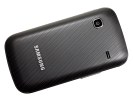


Samsung Galaxy Gio S5660 live shots
The Samsung Galaxy Gio is a phone of compromise. If you’re looking to give smartphones a try, you may be willing to live without a killer screen and a brilliant camera. The Gio will be a good choice for newbies or budget upgraders, if the price is right.
Design and construction
The Galaxy Gio doesn’t scream fashion. It’s a nice simple design that does well to stay away from black gloss and flashy color.

Simplicity in style
Compared to the Galaxy Ace, the Gio is lighter and more compact. It has lost a bit of screen estate but makes up for it with much friendlier size.

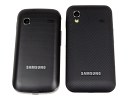


The Samsung Galaxy Gio next to the Galaxy Ace
The front is dominated by the 3.2” touchscreen of HVGA (320x480) resolution. It does well in terms of brightness and contrast. At the maximum brightness setting, the screen is brilliantly lit and the colors look nice and punchy. When you look at the screen from an angle you’ll immediately notice a difference. Colors get washed out and detail is quickly lost.


The HVGA display of the Galaxy Gio
Sunlight legibility is good though, the screen is not too reflective.
As far as touchscreen response goes we have no complaints – the screen is responsive without being overly sensitive (which can often result in unwanted taps).
Above the display, there is the proximity sensor that makes sure the screen gets locked during calls. There’s no ambient light sensor – the display brightness can be adjusted manually.
There’s the typical set of keys at the bottom. The hardware home key is in the middle, with two capacitive controls on either side: Menu and Back. The keys designations are well backlit for comfortable use.

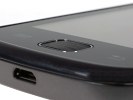
Home button, capacitive Menu and Back keys
This‘s the layout of choice for Samsung’s Android phones. A notable exception is the Google Nexus S with its four capacitive keys.
On the left hand side of the Samsung Galaxy Gio S5660 there’re the lanyard eyelet and the volume rocker. The volume rocker key is quite thin but prominent enough to use comfortably.


Volume rocker and lanyard eyelet
The Power/Lock key is on the right (as on many Samsung phones), which makes it accessible with both the thumb of the right hand or the index finger of the left. A long press of the lock key will let you set Silent or Flight mode.

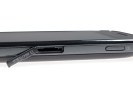
Power/lock button and MicroSD card slot
The other thing on the right is the lid-covered microSD card slot.
At the top of the phone you’ll only find the 3.5 mm headphone jack.
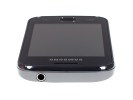
3.5 mm audio jack at the top
The USB port is at the bottom of the phone, used for both charging and data connections. USB charging off a computer is enabled too. There’s also a mouthpiece.

USB port and microphone
The back of the device reminds us of the Galaxy Ace, though with an important difference. The dot-patterned back of the Gio is smooth, not finely grooved like the Ace’s. Fingerprints are out of the question but the grip is not as good as the rubbery texture of the Ace.
The 3MP camera lens is in the top left corner. There’s no LED flash and no lens protection either.


The back panel is nicely textured
The other thing to note at the back is the loudspeaker grill.

The 1350mAh Li-ion battery
Underneath the battery cover is the SIM card compartment and the 1350mAh Li-ion battery. It’s quoted at 610 hours of standby (460 h in 3G) and up to 11 hours of talk time (6 h 40 min in 3G).
The Samsung S5660 Galaxy is a phone of solid build and subtle styling. In a way it’s a lighter version of the Galaxy Ace – would make sense to be less expensive too. After all you’re getting a smaller screen and a downgraded camera. The rest of the ingredients of a solid and reliable smartphone are there though.

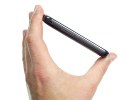
Samsung Galaxy Gio in hand
In a market of ever-growing processing power and screen size, the Gio fits right in the middle – safe from hard-hitting flagships. It’s a phone that can easily connect with its audience – with a good feature set and sensible styling.




0 comments:
Post a Comment